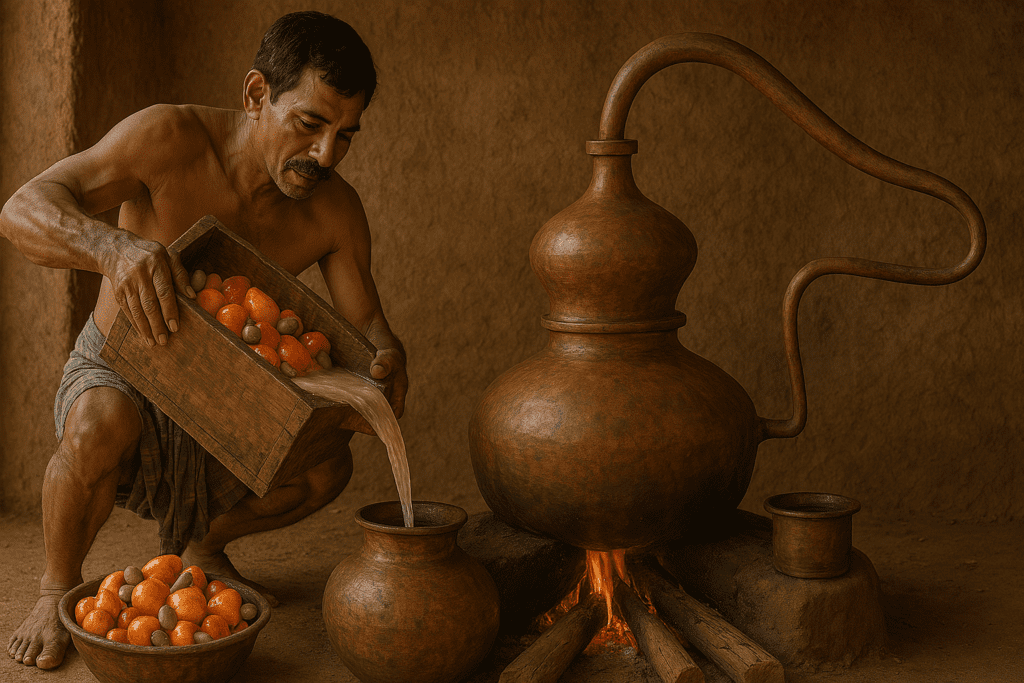Beyond the tourist attractions, Goa is home to a rich cultural legacy that is intricately entwined with a spirit as distinct and powerful as the region itself: Feni. Ignore mass-produced alcoholic beverages. Feni is an experience that exemplifies the age-old workmanship that has been handed down through the centuries. It’s a spirit that was created from the abundance of Goa’s orchards, distilled using traditional methods, and infused with the spirit of the area. Join us as we explore Goa’s traditional distilleries, also known as “bhattis,” and learn about the intriguing method used to make this famous beverage.
Two Fruits, Two Distinct Flavors:
First, it’s important to realize that there are two main types of Feni, each of which is derived from a distinct fruit: Made from the fermented juice of ripe cashew apples, cashew feni is the most well-known and popular. A more regional specialty, coconut feni is made from the sap of the coconut palm, also called “toddy.”
This article will mostly concentrate on the more common Cashew Feni production.
Stepping Back in Time: The Traditional Bhatti
Picture a rustic scene, tucked away among cashew plantations. The delicious, slightly acrid scent of fermenting fruit fills the air. This is the bhatti, the center of a typical Feni distillery. Here, the equipment is frequently straightforward, practical, and rich in history; forget shiny stainless steel.
The Journey of the Cashew Apple:
Harvesting the Bounty: Ripe cashew apples are carefully harvested to start the process. The cashew nuts that we often eat are grown independently from them. The highlight of the Feni show is the juicy apple, which is frequently disregarded elsewhere.

Crushing the Fruit: The apples are traditionally dropped into a “colmbi,” which is a basin carved out of rock. Here, the fruit’s valuable juice is delicately stomped on by barefoot workers. Despite its apparent simplicity, this ancient technique is thought to give the finished object a distinctive personality. The goal of modern distilleries is still to extract the sweet juice, even if they may use mechanical crushers for efficiency.
Gathering the “Niro”: The extracted juice, sometimes referred to as “niro,” is gathered in plastic containers or earthen pots. Despite its limited shelf life and inherent sweetness, this fresh juice is frequently drunk on its own as a cool beverage.
The Magic of Fermentation: After that, the niro is moved into big earthen pots or occasionally fiberglass tanks to undergo fermentation. The natural yeasts found on the fruit and in the environment do their magic, turning the sugars into alcohol, without the need for artificial yeasts. Usually, this process takes a few days.
The Distillation Art:
The alchemy really takes place here. Distillation of the fermented wash is now possible. It is impressive to see the traditional still, which is frequently a copper pot still.
The Still (Bhatti): A big copper pot cooked over a wood fire makes up the still. The pot is filled with the fermenting liquid.
Condensation and Vaporization: Because alcohol has a lower boiling point than water, it vaporizes when the pot warms up. These vapors pass through a connecting pipe, which is frequently composed of clay or copper.
The Collector: A condenser, usually a coil immersed in cool water, is reached by the pipe. The alcohol vapors cool down and return to liquid form at this point.
Three Steps in the Distillation method: A three-step distillation method is frequently used in traditional Feni manufacturing.
Urrack: A lower-proof spirit known as “urrack” (around 15-20% ABV) is produced by the initial distillation. It smells strongly like fruit and is frequently eaten fresh.
Cazulo: A stronger spirit known as “cazulo” or “caju feni” (around 40–45% ABV) is produced by the second distillation. The most prevalent type of Feni is this one.
Batti Feni: To produce an even more powerful and sophisticated spirit, which is frequently aged and highly valued, some distilleries carry out a third distillation.
The Coconut Feni Story:
Coconut Feni similarly goes through fermentation and distillation, albeit the first steps of the process are different. Before being distilled in a conventional still, the “toddy,” or sweet sap extracted from coconut palms, is collected and allowed to ferment naturally. The flavor characteristic of Coconut Feni is distinctly smoky and slightly salty.
A Taste of Tradition:
Going to a traditional Feni bhatti is an immersion into Goan culture, not merely a chance to observe a production process. The distinct perfume of the fermenting fruit, the rustic charm of the distilleries, and the friendliness of the locals all combine to create a singular sensory experience.
Respecting the Craft:
Ancient methods are still an essential part of Goa’s legacy, even though some contemporary distilleries have embraced more efficient technologies. These modest bhattis frequently help out the community and maintain Feni’s distinct identity.
So, the next time you find yourself in Goa, venture beyond the beaches and seek out a traditional Feni distillery. Witness the dedication, the craftsmanship, and the passion that goes into creating this iconic spirit. You’ll not only get a taste of authentic Goa but also gain a deeper appreciation for the traditions that continue to thrive in this vibrant land. Cheers to the spirit of Goa!



